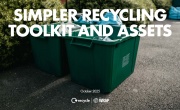An eye on the markets: Textile crowding
Alan Wheeler, Director of the Textile Recycling Association, gives an update on the used clothing and textile recycling market.

The market situation for the UK used clothing and textile recycling industry has been challenging this year. Values of used clothing rose gradually across all grades in the first half of 2017. This was a continuation of a trend that started after last year’s EU referendum and the subsequent fall in the value of the pound, which meant that our British used clothing became a bit cheaper and a bit more affordable for customers in Africa, Eastern Europe and elsewhere.
However, there are signs that this period of increased value is coming to an end. UK-based used clothing exporters are finding that some of their customers abroad are dropping their prices, while delays in payments from Africa are also being reported.
On the domestic side, a number of Textile Recycling Association members have reported that they are picking up return business from charity shops that had left them in the past to go with new collectors offering seemingly market-busting prices for their used clothing. This suggests that the values being offered were unsustainable, rendering the market situation untenable. The squeeze in our markets is also no doubt being affected by inflation, which is beginning to bite and affecting profitability in our sector. This turn in the fortunes of the used clothing market has seen the values being paid to charities and others remain static since the summer.

One of the manifestations of the squeeze has been a move away from UK sorting. This has meant that businesses have reduced the number of grades they sort, while others have stopped sorting in the UK altogether. This means that there are fewer jobs in our sector. Whilst I understand and resolutely defend a business’s decision to stop UK sorting in order to maintain a strong and robust collection business, it does add one more step on the route of UK used clothing to its final market, which can make traceability that little bit harder.
It is really important to maintain a strong sorting base here in the UK, not just because of the jobs it creates, but also because it will help the UK to improve sustainability across the clothing supply chain.
The sustainability of clothing can be improved by switching to more sustainable fibres during production, using less water, eradicating harmful toxins and carcinogens in the dyeing process, and getting the public to wash at 30 degrees centigrade, among other things.
 This article was taken from Issue 90
This article was taken from Issue 90However, true circularity in the clothing industry can only be achieved if we are able to recycle textiles once they have reached the end of their useful life and can find their way back into new products. It is only through sorting that we can ensure that a used textile item can maintain its maximum environmental and economic value and be recovered in the most efficient manner. If the sorting process moves away from the UK, we will have less control over what happens to UK used clothing and textiles and a reduced capacity to implement circular principles.
We also need to address looming international market issues. There are plans to ban imports of used clothing to East African Community (EAC) countries by the spring of 2019. Around 15 per cent of all used clothing exports end up being sent to these countries. Kenya has indicated it may well reverse its decision on the ban, but it is not clear whether this is actually the case and how this decision will affect the other countries. If the ban happens, it will have a profound effect on international used clothing markets.
Meanwhile, China is the new kid on the block and its global market share in the export of used clothing is rising rapidly. In 2010, exports from China accounted for less than 0.1 per cent of all exports of used clothing. By 2015, it had already become the fifth largest exporter in the world, with 5.6 per cent of all global exports. It is inevitable that China will become the world’s biggest exporter of used clothing in the near future. This, along with threats of proposed import bans, means one thing: our global markets for used clothing and textiles are set to become much more crowded, so the drive to develop new markets for recycled clothing and textiles must be continued and accelerated.






